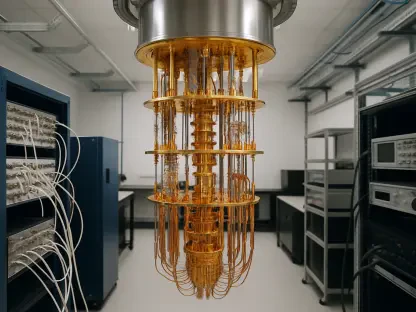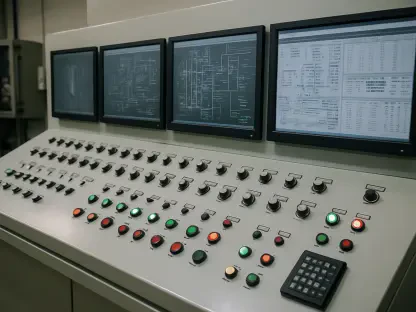As businesses increasingly integrate AI technologies, the demand for robust and scalable AI infrastructure has never been more critical. The year 2024 brings forth significant challenges and advancements in computing, networking, and storage to support AI workloads. This article delves into the key trends and developments shaping AI infrastructure, highlighting the essential solutions and strategic investments required to keep pace with AI innovations.
The Growing Importance of AI Infrastructure
Addressing the Inadequacy of Existing Infrastructures
The rapid adoption of AI in enterprises has exposed the inadequacies of current infrastructures. Existing systems often struggle to meet the demanding workloads of AI, necessitating immediate attention and strategic investments in new technologies. In particular, the need for robust and scalable solutions across various layers of technology, including networking, compute, and storage capabilities, is paramount. Enterprises are faced with the challenge of upgrading or overhauling these components to maintain a competitive edge and ensure efficient AI operations.
Within this landscape, the inadequacy of existing infrastructures is not merely a technical issue but also a strategic concern. Traditional IT systems, primarily designed for conventional workloads, often lack the capacity to process the vast amounts of data required for AI model training and inference. This gap highlights the urgency for enterprises to reassess and innovate their technological frameworks. The integration of advanced hardware and optimized software solutions is critical, as these enhancements can significantly streamline AI processes, enabling enterprises to fully exploit AI’s potential.
The Role of Ethernet in AI Networking
Ethernet continues to play a significant role in meeting the networking demands of AI workloads. Despite alternatives like InfiniBand offering high performance, Ethernet remains a viable option due to its cost-effectiveness and lower complexity. Initiatives like the Ultra Ethernet Consortium, led by industry giants such as AMD, Cisco, Intel, and Microsoft, aim to enhance Ethernet’s capability to handle low-latency and high-bandwidth tasks, enabling enterprises to leverage existing infrastructures while controlling costs. The combination of these advances makes Ethernet an attractive solution for various AI applications.
The sustained relevance of Ethernet in AI networking also reduces the dependency on more complex and expensive solutions. While InfiniBand is known for its superior performance, especially in high-performance computing environments, its implementation and maintenance can be cost-prohibitive for many enterprises. Enhancements in Ethernet technology are making it increasingly capable of supporting sophisticated AI workloads, thus offering a balanced approach between performance and cost. As a result, enterprises can extend the life of their current networking investments and minimize the need for expensive overhauls, promoting a more sustainable approach to AI adoption.
Enterprise Readiness for AI Adoption
Insights from the Cisco 2024 AI Readiness Report
The Cisco 2024 AI Readiness report reveals that most enterprises are not well-prepared to unlock AI’s full potential. A significant gap exists in infrastructure, skills, and data readiness, with only 13% of organizations being entirely prepared for adopting AI. The report highlights the urgent need for enterprises to bridge these gaps to fully realize AI’s benefits. Furthermore, it shows a staggering 79% of companies do not have sufficient GPUs to meet their AI needs, and 24% report a shortage of AI-related expertise, emphasizing the need for specialized training and development programs.
Despite these gaps, there is widespread recognition of AI’s importance, with 98% of organizations acknowledging its potentially transformative impact on business operations. This urgency to adopt AI technologies is reflected in the fact that 85% of companies aim to demonstrate AI’s business impact within a defined timeline. However, the journey toward full AI integration requires more than just acknowledgment. It necessitates a strategic overhaul of existing infrastructures, investment in advanced technology, and significant upskilling of personnel to leverage AI’s full spectrum of capabilities.
Challenges in Data Preprocessing and Cleaning
Data preprocessing and cleaning remain critical challenges for many companies. Around 80% of organizations face difficulties in these crucial steps, which are essential for effective AI implementation. Addressing these challenges is vital for enterprises to harness the full potential of AI technologies and achieve meaningful business outcomes. The complexities involved in data preprocessing stem from the massive volumes of unstructured data that need to be organized, cleaned, and formatted before being used in AI models. This process is labor-intensive and requires specialized tools and expertise.
Moreover, inadequate data preprocessing can lead to faulty AI models, causing inaccurate predictions and insights that can misguide business decisions. Enterprises need to invest in robust data management frameworks and advanced analytics tools to streamline these processes. The adoption of automated data cleaning and preprocessing solutions can significantly reduce the time and effort involved, facilitating smoother and more efficient AI operations. By overcoming these data-related hurdles, companies can ensure that their AI initiatives are built on solid foundations, leading to better and more reliable outcomes.
Trends in Data Center Infrastructure
Surge in Global Data Center Purchases
The rapid adoption of generative AI has significantly influenced trends in data center infrastructure. According to the Dell’Oro Group’s market research, global data center purchases have surged by 38% in the first half of 2024, driven by investments in AI-accelerated servers. This trend is expected to continue, with a projected increase of 35% in infrastructure spending, surpassing $400 billion by year’s end. Such robust growth highlights the industry’s commitment to enhancing the capabilities of data centers to support evolving AI demands, ensuring enterprises can handle the increasing complexity of AI workloads.
The investment surge primarily focuses on acquiring advanced servers and high-performance networking equipment necessary for supporting AI workloads. These hardware upgrades are crucial for processing the vast amounts of data involved in AI model training and inference. Beyond mere capacity expansions, there is a concerted effort to enhance the efficiency, speed, and reliability of data center operations. As enterprises ramp up their AI capabilities, the architecture of these data centers evolves to integrate cutting-edge technologies that ensure optimal performance and resilience.
Investments in Advanced Servers and Networking Equipment
Investments primarily target acquiring advanced servers and high-performance networking equipment necessary for supporting AI workloads. This trend signifies the industry’s move towards enhancing data center capabilities to align with evolving AI requirements, ensuring that enterprises can handle the increasing demands of AI applications. The focus on high-performance servers underscores the need for robust processing power to manage the intricate computations involved in AI tasks. Such investments enable organizations to efficiently scale their AI operations and maintain a competitive advantage in a rapidly evolving technological landscape.
In addition to servers, investments in high-speed networking infrastructure are pivotal. Technologies such as 400G Ethernet and advanced network switches are becoming essential components of modern data centers, facilitating faster data transfer rates and low-latency communication. These advancements are critical for AI applications that require real-time data processing and high throughput. By aligning data center infrastructure with the specific needs of AI workloads, enterprises can achieve greater operational efficiency and unlock new opportunities for innovation and growth.
Network Support Strategies for AI Workloads
Reassessing Network Support Strategies
IT managers are advised to reassess their network support strategies to cater to AI workloads efficiently. AI adoption in large enterprises poses tremendous demands on network infrastructure, necessitating a recalibration of strategies concerning scalability, bandwidth, and latency. Ensuring that networks facilitate low-latency communication between GPUs and storage systems is crucial for effective AI deployment. The high data transfer rates required for AI model training and inference demand meticulously planned network architectures that can handle substantial traffic without compromising performance.
Part of this reassessment involves addressing potential bottlenecks that can impede AI operations. These bottlenecks often arise from outdated or insufficient networking equipment that cannot keep pace with the rapid data exchanges involved in AI processes. Upgrading to high-speed, low-latency networking solutions, such as advanced Ethernet configurations, can significantly enhance the efficiency of AI workflows. By optimizing network support strategies, enterprises can mitigate performance issues, ensure seamless AI deployments, and maximize the return on their AI investments.
Evaluating Ethernet and InfiniBand Technologies
Technologies like Ethernet and InfiniBand are evaluated for their capabilities in supporting AI workloads. While InfiniBand offers high performance, Ethernet enhancements promise a balanced approach to performance and cost. Efficient deployment of AI applications hinges on planning for robust hardware, load balancing, and network optimization, making it essential for enterprises to choose the right technology for their needs. The decision between Ethernet and InfiniBand largely depends on specific use cases and budget considerations, with each technology presenting unique advantages and potential trade-offs.
InfiniBand, known for its low-latency and high-throughput capabilities, is often chosen for environments where peak performance is paramount, such as in high-performance computing clusters. Conversely, enhanced Ethernet solutions, supported by initiatives like the Ultra Ethernet Consortium, offer a more cost-effective and scalable option for many enterprises. These Ethernet advancements increasingly close the performance gap with InfiniBand, making them an attractive alternative for a wider range of AI applications. By carefully evaluating these technologies, organizations can tailor their network infrastructure to meet the precise demands of their AI workloads, ensuring a harmonious balance between cost and performance.
Collaborative Efforts in AI Infrastructure Solutions
Dell Technologies, Deloitte, and NVIDIA Collaboration
The collaborative efforts of Dell Technologies, Deloitte, and NVIDIA in introducing advanced AI Factory infrastructure solutions emerge as a significant development. This initiative aims to streamline the deployment and management of AI workloads, drawing parallels to past endeavors in high-performance computing (HPC) systems. By leveraging the combined expertise and resources of these industry leaders, the collaboration seeks to create integrated solutions that address the complex needs of AI deployments, from compute and storage to networking and software optimization.
One of the key aspects of this collaboration is the emphasis on creating end-to-end solutions that simplify AI adoption for enterprises. By offering pre-configured and tested infrastructure bundles, these vendors can significantly reduce the time and effort required to set up and manage AI environments. This approach not only accelerates AI deployment timelines but also ensures that enterprises can quickly scale their AI operations to meet growing demands. The result is a more agile and responsive AI infrastructure that can adapt to the rapidly changing landscape of AI technologies and applications.
Integrated Compute, Storage, and Networking Solutions
As businesses increasingly integrate AI technologies, the demand for robust and scalable AI infrastructure is more critical than ever. The year 2024 ushers in considerable challenges and advancements across computing, networking, and storage designed specifically to support AI workloads. This article delves into the key trends and developments shaping AI infrastructure, highlighting the essential solutions and strategic investments required to keep pace with AI advancements.
The rapid adoption of AI necessitates advanced computing resources capable of handling complex algorithms and large datasets. Efficient networking infrastructure is vital for seamless data flow and real-time decision-making. Additionally, scalable storage solutions must be in place to manage the vast amounts of data generated by AI applications.
Businesses must strategically invest in these areas to maintain a competitive edge. Emerging technologies such as edge computing, 5G, and AI-optimized hardware are becoming indispensable. Ensuring that infrastructure can adapt to the growing demands of AI will determine an organization’s ability to innovate and succeed in the AI-driven landscape of 2024 and beyond.









